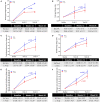Impact of Branched Chain Amino Acid on Muscle Mass, Muscle Strength, Physical Performance, Combined Survival, and Maintenance of Liver Function Changes in Laboratory and Prognostic Markers on Sarcopenic Patients With Liver Cirrhosis (BCAAS Study): A Randomized Clinical Trial
- PMID: 34631765
- PMCID: PMC8494250
- DOI: 10.3389/fnut.2021.715795
Impact of Branched Chain Amino Acid on Muscle Mass, Muscle Strength, Physical Performance, Combined Survival, and Maintenance of Liver Function Changes in Laboratory and Prognostic Markers on Sarcopenic Patients With Liver Cirrhosis (BCAAS Study): A Randomized Clinical Trial
Abstract
Background: This study aimed to investigate the long-term effects of branched-chain amino acids (BCAAs) supplementations on the parameters associated with improved prognosis in sarcopenic patients with liver cirrhosis (LC) and evaluate its impact on cirrhotic-related events. Methods: A 24-week, single-center, randomized, open-label, controlled, two cohort parallel-group intervention study was carried out by comparing the efficacy of BCAAs against lactoalbumin (L-ALB) on 106 sarcopenic patients with LC. The BCAA (intervention) group was treated with 7.2 g BCAA per dose, whereas the L-ALB group was treated with 6.3 g of L-ALB. The primary outcome was to assess the effect of BCAA on the parameters of sarcopenia, such as muscle mass, muscle strength, and physical performance. The secondary outcomes were to study the combined survival and maintenance of liver function changes in laboratory and prognostic markers over the duration of 6 months. Results: The treatment with BCAA leads to the significant improvement in sarcopenic parameters, such as muscle strength, muscle function, and muscle mass. The total cirrhotic-related complications and cumulative event-free survival occurred fewer in the BCAA group than in the L-ALB group. In addition, prognostic markers improved significantly in the study. Conclusion: The current study demonstrated that long-term BCAAs supplementation improved sarcopenia and prognostic markers in patients with advanced LC.
Keywords: albumin; branched-chain amino acid; liver cirrhosis; quality of life; sarcopenia.
Copyright © 2021 Singh Tejavath, Mathur, Nathiya, Singh, Raj, Suman, Mundada, Atif, Rai and Tomar.
Conflict of interest statement
The authors declare that the research was conducted in the absence of any commercial or financial relationships that could be construed as a potential conflict of interest.
Figures




Similar articles
-
Sarcopenia impairs prognosis of patients with liver cirrhosis.Nutrition. 2015 Jan;31(1):193-9. doi: 10.1016/j.nut.2014.07.005. Epub 2014 Jul 30. Nutrition. 2015. PMID: 25441595
-
Branched-chain amino acids supplementation improves liver frailty index in frail compensated cirrhotic patients: a randomized controlled trial.BMC Gastroenterol. 2023 May 15;23(1):154. doi: 10.1186/s12876-023-02789-1. BMC Gastroenterol. 2023. PMID: 37189033 Free PMC article. Clinical Trial.
-
Effects of Branched-Chain Amino Acid (BCAA) Supplementation on the Progression of Advanced Liver Disease: A Korean Nationwide, Multicenter, Prospective, Observational, Cohort Study.Nutrients. 2020 May 15;12(5):1429. doi: 10.3390/nu12051429. Nutrients. 2020. PMID: 32429077 Free PMC article.
-
Efficacy of branched chain amino acids supplementation in liver cirrhosis: A systematic review and meta-analysis.Clin Nutr. 2022 Jun;41(6):1171-1190. doi: 10.1016/j.clnu.2022.03.027. Epub 2022 Apr 1. Clin Nutr. 2022. PMID: 35500317
-
Branched-chain amino acid supplementation in patients with liver diseases.J Nutr. 2005 Jun;135(6 Suppl):1596S-601S. doi: 10.1093/jn/135.6.1596S. J Nutr. 2005. PMID: 15930476 Review.
Cited by
-
Association of chronic liver disease with bone diseases and muscle weakness.J Bone Miner Metab. 2024 Jul;42(4):399-412. doi: 10.1007/s00774-023-01488-x. Epub 2024 Feb 1. J Bone Miner Metab. 2024. PMID: 38302761 Review.
-
Associations of sleep quality with the skeletal muscle strength in patients with type 2 diabetes with poor glycemic control.J Diabetes Investig. 2023 Jun;14(6):801-810. doi: 10.1111/jdi.14007. Epub 2023 Mar 19. J Diabetes Investig. 2023. PMID: 36934440 Free PMC article.
-
The Emerging Role of Branched-Chain Amino Acids in Liver Diseases.Biomedicines. 2022 Jun 18;10(6):1444. doi: 10.3390/biomedicines10061444. Biomedicines. 2022. PMID: 35740464 Free PMC article. Review.
-
Use of Branched-Chain Amino Acids as a Potential Treatment for Improving Nutrition-Related Outcomes in Advanced Chronic Liver Disease.Nutrients. 2023 Sep 28;15(19):4190. doi: 10.3390/nu15194190. Nutrients. 2023. PMID: 37836474 Free PMC article. Review.
-
Efficacy of different nutrition interventions on sarcopenia in patients with cirrhosis: a systematic review and network meta-analysis.BMC Nutr. 2025 Feb 12;11(1):39. doi: 10.1186/s40795-025-01028-y. BMC Nutr. 2025. PMID: 39940017 Free PMC article.
References
LinkOut - more resources
Full Text Sources
Medical
Miscellaneous

